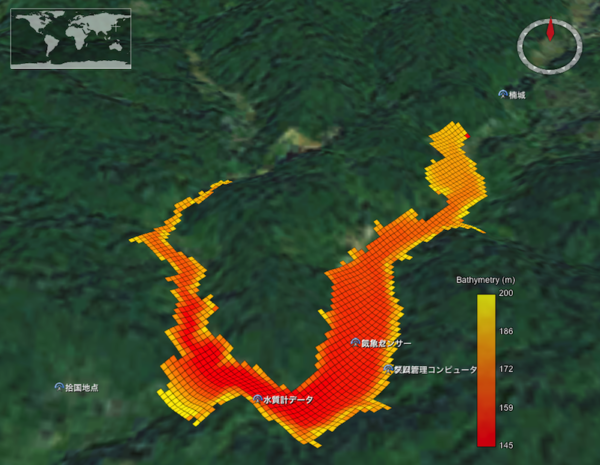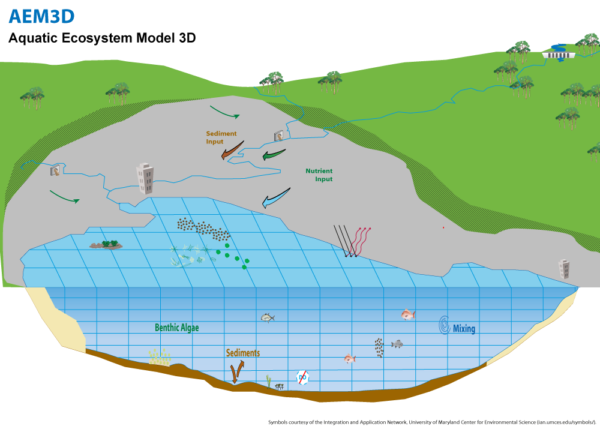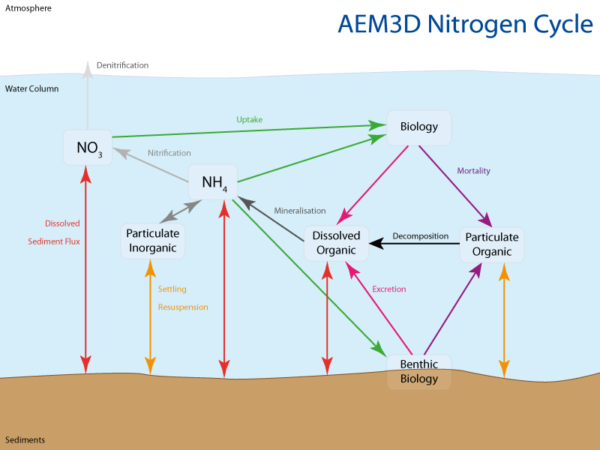
HydroNumerics develops, uses, sells and supports the 3-Dimensional coupled Hydrodynamic-Aquatic Ecosystem Model, AEM3D for simulating all water resources, including lakes, reservoirs, estuaries and coastal oceans. This model is based on the internationally recognised model ELCOM-CAEDYM developer by the Centre for Water Research. HydroNumerics staff were integral in the development of ELCOM-CAEDYM and continue to develop and improve AEM3D and provide support to third party users.
AEM3D is used to simulate the velocity, temperature, salinity, nutrients and biogeochemistry in surface waters that are subjected to environmental and anthropogenic forcing such as wind, tides, surface heating and cooling, inflows, withdrawals, bubblers and mixers.
It is s designed to simulate over timescales of days to years and at spatial scales of metres to kilometres. AEM3D is suited for simulation of transport, mixing, stratification, tidal exchange, inflow dynamics, and dispersal conditions under a range of flow regimes. AEM3D can be run either in stand alone hydrodynamic mode or as a fully coupled hydrodynamic biogeochemical model.
AEM3D includes a library of algorithms that represent the key biogeochemical processes influencing water quality under the simulated physical conditions. This includes primary production, secondary production, nutrient, carbon and metal cycling, oxygen dynamics and the transport and deposition of suspended solids. AEM3D provides flexible set-up options so a user can focus on processes of interest.
The hydrodynamic solver used in AEM3D solves the physical equations for the motions of the water body and the transport and mixing of all simulated constituents due to these motions. Some of the specific hydrodynamic capabilities include:
- Variable resolution grid structure
- Free surface solution
- Inflow dynamics
- Outflow dynamics
- Surface thermodynamics
- Scalar advection
- Scalar diffusion
- Light environment
- Vertical mixing and stratification using Turbulent Kinetic Energy budget
- Spatially variable wind and thermodynamic boundary conditions
- Morphometric changes due to settling and resuspension of particulates
- Surface wave stresses via coupling to SWAN wave model
- Destratification devices
- Lagrangian and non-Lagrangian particle tracking
- Levies and barriers
- Variable bottom drag
- Dynamically generated boundary conditions
- Parallel processing
- Wetting and drying
- Effects of sediment reflection, heat loss and retention
- Groundwater exchange
- Dredging plans




AEM3D houses a series of mathematical algorithms that represent biogeochemical processes that govern water quality including primary and secondary production, nutrient and metal cycling, oxygen dynamics and sediment interactions. AEM3D simulates variables at the chemical and biological species level (e.g. organic-labile and refractory and inorganic nitrogen, carbon and phosphorus species, dissolved and precipitated metals, multiple phytoplankton and zooplankton species, infectious and dormant pathogenic organisms, multiple sediment classes). In addition, AEM3D solves for the atmospheric and sediment interactions of chemical species that is based on both physical mixing processes and chemical reaction, including microbial mediated chemical change. The rates of reaction are dictated by the water properties including species concentration, temperature and pH. The configuration of AEM3D is flexible so that the user can select to model the processes that are of interest or within the limitations set by the availability of data and parameters.
Water Quality
The water quality capabilities of AEM3D including simulation of the full Oxygen, Phosphorus, Nitrogen, Silica and Carbon cycles as well as modelling of multiple suspended solids groups. Inorganic and two organic (labile and refractory) nutrient pools can be simulated, both in dissolved and particulate forms. Processed that are modelled include:
- Settling and resuspension;
- Sediment Oxygen demand;
- Sediment fluxes of both inorganic and inorganic components;
- Decomposition of particulate organic matter to dissolved;
- Mineralisation of organic to inorganic;
- Nitrification, denitrification; and
- Biological uptake.
Ecology
AEM3D has the capability to simulate a large number of biological species that may be present in the water body. The number and types of species modelled is governed by the questions being asked and the availability of data. The organisms that can be simulated included:
- Phytoplankton;
- Zooplankton;
- Fish;
- Seagrasses;
- Macroalgae;
- Clams and mussels; and
- Pathogens.
Geochemistry
The geochemistry model in AEM3D allows the user to choose the ’components’ to simulate, and then solves for the equilibrium speciation of the solution. The module will solve for pH and other solution properties, and optional mineral or gas phases can be included. Many kinetic transformations (e.g. redox reactions) between simulated components are also included. Metals may be simulated as part of the model and can also be active within the biological cycles. The module is flexible and simple in its configuration and can be used in the water column and in the sediment if the dynamic sediment diagenesis model is also being simulated. A seperate simpler metal and pH model is also available.
Hydronumerics can provide customised training programs to ensure you are able to effectively use AEM3D in your projects. We can provide training in a number of forms including:
- Customised project based training;
- Generic training courses; and
- Project or model reviews.
Assistance is also provided through the HN Software Forums
Please contact us at [email protected] to discuss your training requirements.
Demo Versions
A free download of a demo version of the AEM3D model is available:
The demo version is limited to:
- Two weeks simulation time;
- One passive tracer;
- No ice model;
- No restarting;
- No dynamic bathymetry and
- No dynamic boundary condition files.
These features can be unlocked by Purchasing a License
AEM3D Release DownloadsLatest Release Version of code
You must be a registered user to download the demo version.
You can login or register Here
Latest Development Version of code
You must be a registered user to download the demo version.
You can login or register Here
Windows users may need to download the Intel redistributable libraries found Here to run the OpenMP version.
Visualisation
Provided for free is HydroHubLite a lite version of Hydronumerics' Decision Support System HydroHub. HydroHubLite allows users to:
- Load and view all model input and output files;
- Output can be viewed as images and movies;
- Load external data files;
- Generate boundary condition files;
- Generate bathymetry files; and
- Run the model.
You must be a registered user to download the demo version.
You can login or register Here
Documentation
The AEM3D user manual is included in the Demo download.
AEM3D is provided under a simple single-user licences costing $AUD100 (+GST if in Australia). Each license provides you with one year worth of updates and allows you to install the software on an unlimited number of machines for one user. For site or department wide licenses please contact us at [email protected]. We are open to providing source code access for users who we feel can make a contribution to the ongoing model development.
The licence conditions can be downloaded Here

